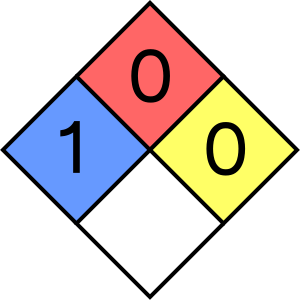IDEXX TECTALERT ENT (ENA)
Basic information
- Chemical formula(s): Contains Sodium carbonate (7.51%), Phenethyl Alcohol (5.72%)
- Other names: Tectalert ENT (ENA), IDEXX Reagent
- Product Code: 98-0018015-00
- International Chemical Safety Card (ICSC): Multiple components - see individual ICSC cards
- Flammability: no
- Description: Laboratory reagent for enterococcus bacterial testing. Contains sodium carbonate and phenethyl alcohol as active ingredients.
NFPA 704 (fire diamond)

- Health (blue): 1 - poses no health hazard, requires no precautions, and would offer no hazard beyond that of ordinary combustible materials.
- Flammability (red): 0 - will not burn under typical fire conditions.
- Instability–reactivity (yellow): 0 - normally stable, even under fire exposure conditions, and is not reactive with water.
- Special notice (white): - - no special hazards.
Hazard statements
| Code | Phrase |
|---|---|
| H319 | causes serious eye irritation |
Precautionary statements
| Code | Phrase |
|---|---|
| P264 | wash thoroughly after handling |
| P280 | wear eye protection/face protection |
| P305+P351+P338 | IF IN EYES: rinse cautiously with water for several minutes, remove contact lenses if present and easy to do, continue rinsing |
| P337+P313 | if eye irritation persists: get medical advice/attention |
Protective measures
Gloves
Based on the safety data sheet recommendations for handling irritating substances:
- Nitrile: good - suitable for contact (recommended for laboratory reagents).
- Natural latex or rubber: good - adequate for contact.
- Butyl rubber: good - chemical resistant gloves.
- PVC: fair - suitable for contact.
Safety goggles
- Wear safety glasses with side shields (or goggles) when handling this product.
- Corrective glasses are not considered safety goggles.
- Handle with adequate ventilation.
Clothing
- Wear suitable protective clothing and closed shoes.
- Long sleeves recommended.
- Remove and wash contaminated clothing before reuse.
Respiratory protection
- Ensure adequate ventilation.
- In case of insufficient ventilation, wear suitable respiratory equipment.
- Minimize dust generation and accumulation.
Spill management
- Do not touch damaged containers or spilled material unless wearing appropriate protective clothing.
- Ensure adequate ventilation.
- Use personal protective equipment as required.
- Prevent entry into drains, sewers, or water bodies.
- For large spills: Wet down with water and dike for later disposal. Shovel material into waste container.
- For small spills: Sweep up or vacuum up spillage and collect in suitable container for disposal.
- Clean surface thoroughly to remove residual contamination.
- Never return spills to original containers for re-use.
- Dispose according to local hazardous waste regulations.
Special warnings
- Causes serious eye irritation - avoid contact with eyes.
- Dusts may irritate respiratory tract, skin and eyes - minimize dust generation.
- Keep out of reach of children.
- Store in a well-ventilated place away from incompatible materials.
- Keep container tightly closed.
- Always observe good personal hygiene measures.